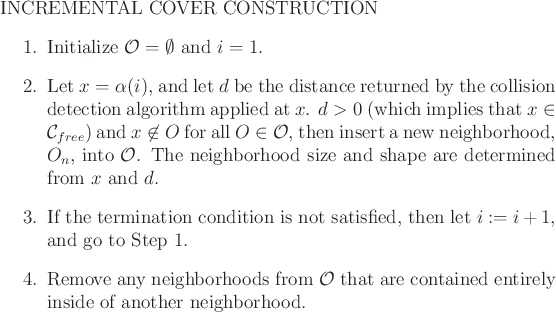
Next: Defining new neighborhoods Up: 8.5.1 Computing a Composition Previous: 8.5.1.2 Defining a feedback
There are numerous alternative ways to construct a cover. To
illustrate the ideas, an approach called the sampling-based
neighborhood graph is presented here [983]. Suppose that
![]() , which is a subset of some configuration space. As
introduced in Section 5.4, let
, which is a subset of some configuration space. As
introduced in Section 5.4, let ![]() be a dense,
infinite sequence of samples in
be a dense,
infinite sequence of samples in ![]() . Assume that a collision
detection algorithm is available that returns the distance,
(5.28), between the robot and obstacles in the world.
Such algorithms were described in Section 5.3.
. Assume that a collision
detection algorithm is available that returns the distance,
(5.28), between the robot and obstacles in the world.
Such algorithms were described in Section 5.3.
An incremental algorithm is given in Figure 8.17.
Initially, ![]() is empty. In each iteration, if
is empty. In each iteration, if
![]() and it is not already contained in some neighborhood, then a
new neighborhood is added to
and it is not already contained in some neighborhood, then a
new neighborhood is added to ![]() . The two main concerns are 1) how
to define a new neighborhood,
. The two main concerns are 1) how
to define a new neighborhood, ![]() , such that
, such that
![]() , and
2) when to terminate. At any given time, the cover is approximate.
The union of all neighborhoods is
, and
2) when to terminate. At any given time, the cover is approximate.
The union of all neighborhoods is
![]() , which is a strict subset
of
, which is a strict subset
of ![]() . In comparison to Figure 8.15, the cover is a
special case in which the neighborhoods do not extend beyond
. In comparison to Figure 8.15, the cover is a
special case in which the neighborhoods do not extend beyond
![]() .
.
 |